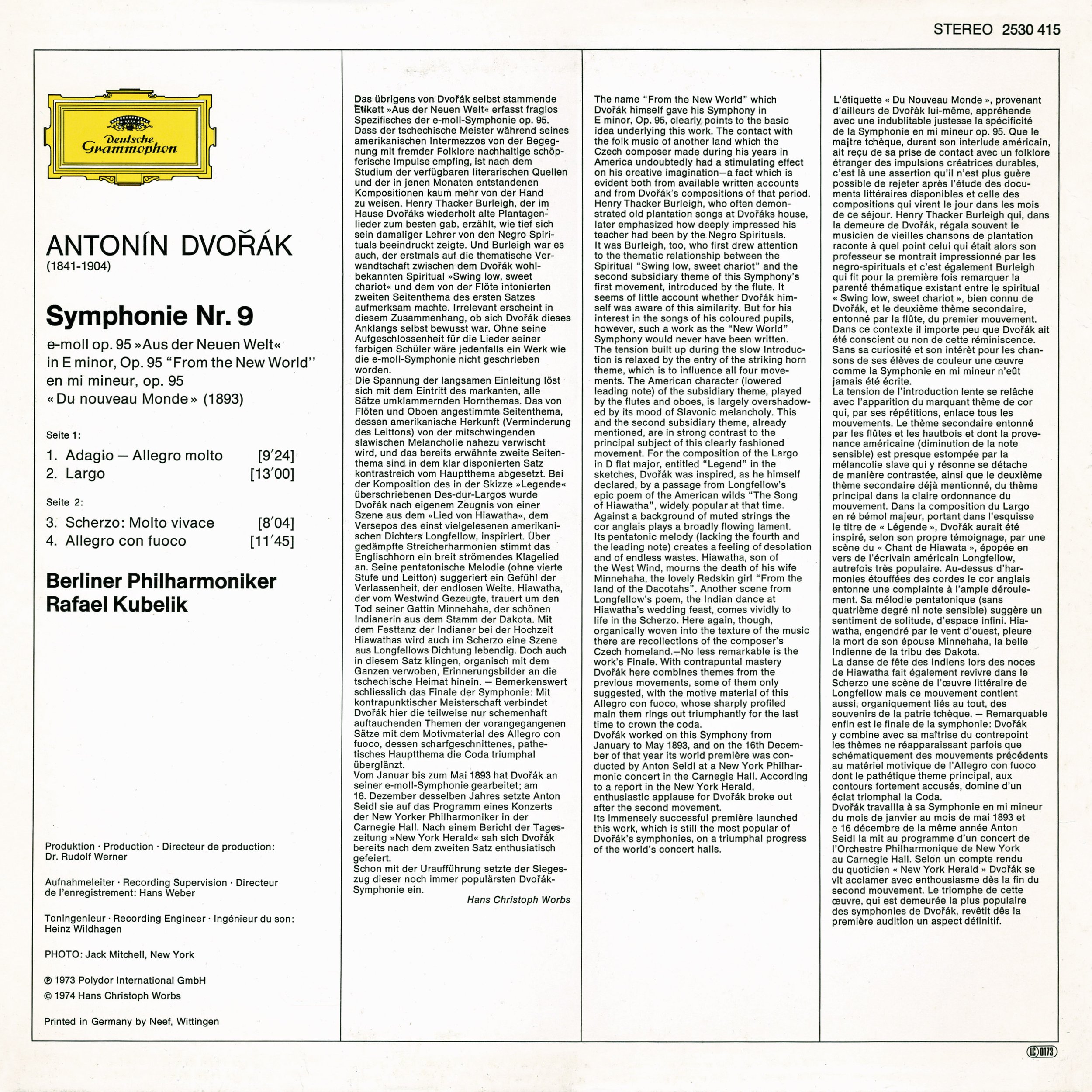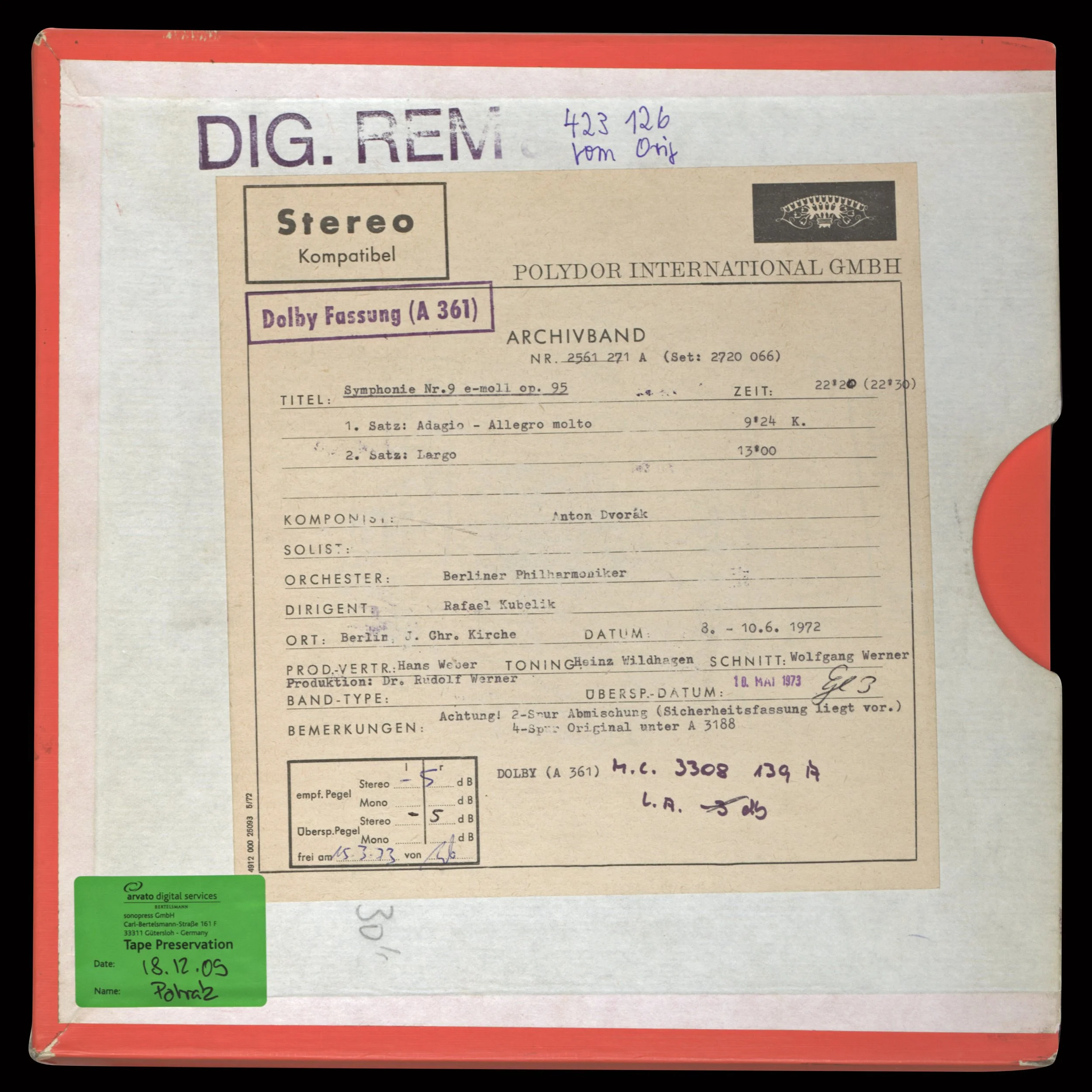Antonín Dvorák
Symphony No. 9 / E minor / op. 95
„From the New World“ / Berliner Philharmoniker / Rafael Kubelik
Publisher: Horch House
Playing time: 42 min
Specifications: half track ¼", stereo, RTM SM900, CCIR, 510 nWb/m, 38 cm/s
Reel(s): 2 standard metal reels, with stickers
Packaging: 1 deluxe cardboard box
Inserts: 1 insert folder with 2 insert sheets and 4 photo prints
Homepage: https://www.horchhouse.com/
Author: Claus Müller
Antonín Dvořák was born in Bohemia, now part of the Czech Republic, in 1841. His musical education in Prague fostered his early musical talent. He studied violin, organ, piano and composition at Antonín Liehmann's organ school and later at the Prague Conservatory. He had nine children with his wife Anna Čermáková. Dvořák was also very productive as a composer, creating symphonies, chamber music, operas and concertos and exerting a significant influence on the development of Czech music. From 1892 to 1895, he held the position of director of the National Conservatory of Music in New York City (USA). Dvořák spent the last years of his life in Prague, where he died in 1904. To this day, he is considered one of the most important composers of the 19th century and one of the best-known representatives of Bohemian music.
In his symphony "From the New World", which is considered one of his best-known works, composed in 1893, he processes his impressions of the USA by incorporating elements of African American, Native American and American folk music. In terms of structure and expression, however, the piece remains rooted in European Romanticism. The style of the 9th Symphony in E minor is characterized by melodic and catchy melodies. While the first movement begins impulsively, already revealing the theme of the symphony, which can be heard again and again in different variations in all four movements, the second movement with its beautiful melody, also known as "Goin' Home", invites the listener to dreamy indulgence. The American influences become clear in the third movement. The fourth and final movement is introduced by the main theme and takes up the motifs of the previous movements again with wonderful melodic arcs. The musical images are masterfully clustered, fitting together like a mosaic and finally preparing the finale, which creates a very well-rounded picture of the entire work.
The 1972 recording of the Berlin Philharmonic Orchestra with conductor Rafael Kubelik is very popular and is very well suited for a master tape copy due to its excellent dynamics, coupled with a very well-placed and concentrated orchestra under the world-famous conductor Rafael Kubelik, and undoubtedly offers the pinnacle of musical listening. As early as the first movement, the powerful main theme, in which loud and quiet passages alternate at short intervals, invites concentrated listening. Individual instruments, groups of instruments, but also the entire body of sound of the concerto, are perceptible in every detail. Anyone who has ever heard a concert at the recording venue, the Jesus-Christus-Kirche in Berlin (Germany), will appreciate the extraordinarily good acoustics. The original archive tapes were remastered in analog by Christoph Stickel (CS Mastering). Listening to this production at a high volume triggers an enormous enjoyment factor. Tape lovers will benefit from a work that cannot be approached more closely than with the studio master tape copy from Horch House.
———————————————————————————————————————————————————————
Differences between the three Horch House tape versions Studio, Standard and Start
In addition to the Studio version, Horch House also offers the Standard and Start versions. The standard version (320 nWb/m) has 4 dB less level than the studio version (510 nWb/m). This makes it about half as loud. As the physical tape noise always has the same level and therefore the same volume, you will hear slightly more noise in quiet orchestral passages and at high levels. Provided you have an appropriately high-quality playback device and an adequate stereo system, the very last and smallest nuances of the music will no longer stand out from the noise in the overall context of the standard version. I would recommend the studio version to such listeners. There is a further 2 dB difference in level between the standard version (320 nWb/m) and the start version (250 nWb/m). This difference is then more in the range of the perception limit. In contrast to the other two versions, the start version runs at half speed. The standard version therefore offers a very solid middle ground with an excellent price-performance ratio.
For tape owners with four-track devices, the Start version with its compatibility with two-track recordings will be of interest. Since the tapes at Horch House are recorded with butterfly heads (area 1 in the figure), the two stereo tracks cover track 1 and track 3 when played back in a four-track device, as can be seen in area 2. Track 1 and track 3 (or tracks 2 and 4) are standardized for stereo operation on tape recorders. In correlation to the track width (2.75 mm versus 1.05 mm), the playback will occur with a level loss of approx. 8 dB, which should be the optimum level for most 4-track tape recorders. The music information remains fully present at the different track widths. As shown in section 3, recordings with a 2.0 mm separating track would not be compatible for 4-track playback.
Figure: Comparison of the compatibility of 2-track and 4-track tape recordings
Translated from German with DeepL.com (free version)
Music:
Sound:
The entire content and the individual elements of the web page are the intellectual property of Claus Müller and are subject to copyright protection. They may not be copied or imitated in whole or in part by the user; this applies to texts, logos and image components. Any modification, duplication, distribution or reproduction of the website or parts thereof, in any form whatsoever, is not permitted without the prior written consent of Claus Müller.
Der gesamte Inhalt und die einzelnen Elemente dieser Webseite sind geistiges Eigentum von Claus Müller und unterliegen dem Schutz des Urheberrechts. Sie dürfen vom Nutzer weder kopiert noch im Ganzen oder in Teilen imitiert werden; dies gilt insbesondere für Texte, Logos und Bildbestandteile. Jegliche Veränderung, Vervielfältigung, Verbreitung oder Wiedergabe der Webseite sowie Teilen hiervon, gleich welcher Art, ist ohne vorherige schriftliche Zustimmung von Claus Müller nicht zulässig.





